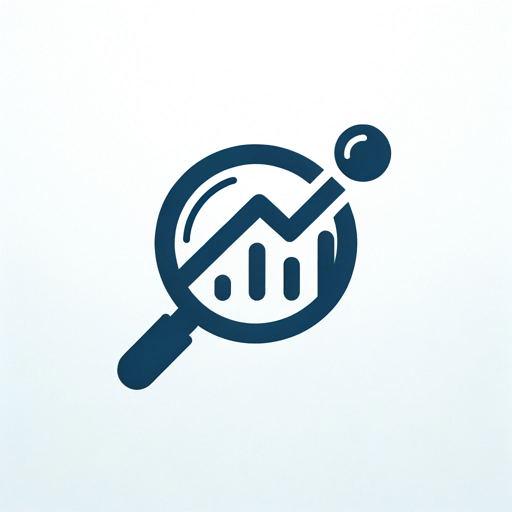Pricing Analyst-price elasticity and sensitivity insights
AI-powered pricing insights for profitability
Analyze this sales data for price sensitivity trends.
How does economic shift affect price elasticity?
What does this customer feedback say about our pricing?
Find reports on consumer behavior in this market.
Related Tools
Load MoreFinancial Analyst
Virtual financial expert providing in-depth stock analysis, combining insights from top financial certifications with real-time market data to offer comprehensive investment assessments. Not an investment advice, DYODD.

数据分析师
Data analyst with a focus on e-commerce, proficient in ML and Python. Speaks Chinese.

Market Research and Trends Analyst
Market research expert, offering tailored insights and trends analysis

Pricing Strategies
Confused on how to price your product? This GPT helps you come up with the best way to price your product to meet your goals.

Financial Analyst
Expert in financial markets, strategies, and analysis. "A senior financial analyst with 20 years of experience, specializing in financial auditing, valuation, and investment analysis."

Resell Assistant ( Arbitrage Price Analyst )
Sorce Like a Pro! Snap and upload item photos and let GPT analyze the condition, providing fair buy and sell price recommendations based on sold comps across eBay. Streamline your item comping process for efficient and profitable reselling.
20.0 / 5 (200 votes)
Overview of Pricing Analyst
Pricing Analyst is a specialized tool designed to analyze price sensitivity, elasticity, and market trends, aimed at helping businesses make informed pricing decisions. Its core purpose is to assess how changes in price influence consumer demand and profitability, drawing on quantitative sales data, qualitative feedback, and external market conditions. This approach ensures a balanced view, combining the numerical insights with an understanding of customer perception and behavior. A key function is identifying optimal pricing strategies by evaluating how different customer segments react to price changes, thus improving profitability while maintaining customer satisfaction. For example, in a scenario where a retailer is unsure about how to price a new product, Pricing Analyst can examine historical sales data of similar products and market trends to recommend an ideal price that balances demand and margin. The tool helps businesses navigate complex pricing decisions, allowing them to anticipate customer reactions to pricing changes and avoid missteps that could lead to revenue loss.

Key Functions of Pricing Analyst
Price Sensitivity and Elasticity Analysis
Example
A company wants to raise the price of a subscription service but is unsure how it will affect customer churn. Pricing Analyst runs an analysis using historical data to predict how much demand will drop for every dollar increase in price, enabling the company to find a sweet spot where they maximize revenue without losing too many customers.
Scenario
For a SaaS provider looking to revise its subscription pricing, this analysis helps determine the exact price point where increased revenue from a higher price doesn’t outweigh the potential loss in customer base.
Customer Segmentation and Trend Analysis
Example
An e-commerce business segments its customers based on purchasing patterns and discovers that younger customers are more sensitive to price changes than older customers. Pricing Analyst helps the company offer targeted discounts to younger customers while maintaining regular pricing for others.
Scenario
In retail, different segments of the customer base may react differently to the same price changes. A detailed segmentation analysis allows businesses to offer personalized promotions and optimize pricing for each group to maximize revenue and customer loyalty.
Predictive Modeling for Future Pricing
Example
A fashion retailer uses Pricing Analyst to forecast the demand for winter clothing based on pricing trends from previous years. The tool integrates historical data and external factors like weather forecasts and economic conditions to predict how future pricing adjustments will impact demand.
Scenario
Seasonal industries, like fashion or tourism, rely heavily on demand forecasting. By analyzing historical trends and external factors, businesses can adjust their pricing strategy proactively, ensuring they meet demand while maximizing profitability.
Target Users of Pricing Analyst Services
Retailers and E-Commerce Businesses
These businesses often have a wide range of products and need to continuously adjust pricing based on competition, inventory levels, and customer demand. Pricing Analyst helps them optimize their pricing strategies by analyzing historical sales data, consumer trends, and market conditions, ensuring they stay competitive while maximizing profit margins.
Subscription-Based Businesses (SaaS, Streaming, etc.)
Subscription services need to manage churn rates carefully, as even small pricing changes can lead to significant customer loss. Pricing Analyst enables these businesses to analyze how sensitive their customer base is to price changes, and it helps them find the optimal price points that increase revenue without significantly impacting customer retention.

How to Use Pricing Analyst
Step 1
Visit aichatonline.org for a free trial without login; no need for ChatGPT Plus.
Step 2
Prepare your dataset: Gather your historical sales data, customer feedback, or survey responses to be uploaded for analysis.
Step 3
Upload the data. Drag and drop your files or provide a direct data link for processing and analysis within the tool.
Step 4
Specify your objectives: Define specific goals like price elasticity analysis, identifying customer segments, or sales forecasting to tailor the analysis.
Step 5
Review and act: Review the detailed pricing analysis report with actionable recommendations to adjust pricing strategies effectively.
Try other advanced and practical GPTs
Je suis votre rédacteur
AI-powered content creation tool

Prompt Engineer
AI-powered prompt creation tool

The AI Recruiter
AI-Powered Recruiting, Simplified

SkillsGPT
AI-powered Skills Management Solution

BLANK Fixer
AI-powered Contextual Replacement for Precision

Network Engineer Guru
AI-Powered Networking Guidance at Your Fingertips

AvoidTurnAi
AI-Powered Text Humanizer
3D-Designer
AI-Powered 3D Design Made Easy

Unifi Assistant
AI-powered assistant for Unifi networks

Bea - relationship psychology
AI-powered guidance for deeper relationships.

GPT Creator's Cottage - Creative GPT Place
AI-powered creativity, your ideas, unleashed.

Hiring and Recruiting Assistant
Efficient AI-Powered Candidate Search

- Market Research
- Sales Forecasting
- Customer Segmentation
- Price Sensitivity
- Demand Analysis
Frequently Asked Questions about Pricing Analyst
What kind of data is required to use Pricing Analyst?
You need historical sales data, customer feedback, or survey responses. The tool analyzes these inputs to identify price sensitivity, elasticity trends, and customer segments.
Can Pricing Analyst handle multiple customer segments?
Yes, Pricing Analyst is designed to handle segmentation and provide insights for different customer groups based on demographics, purchase behavior, or other criteria.
Does the tool provide predictive analytics?
Yes, Pricing Analyst offers predictive modeling to forecast how future price changes may impact demand and profitability, based on past data and market trends.
How does Pricing Analyst incorporate customer feedback in the analysis?
Customer feedback is used to enrich quantitative data, offering insights into perceived value and consumer sentiment, helping to refine pricing strategies beyond raw sales figures.
What industries is Pricing Analyst most suitable for?
It is ideal for retail, e-commerce, SaaS, hospitality, and any business that relies on pricing strategies to drive sales and profitability. The tool adapts to various markets and customer behaviors.